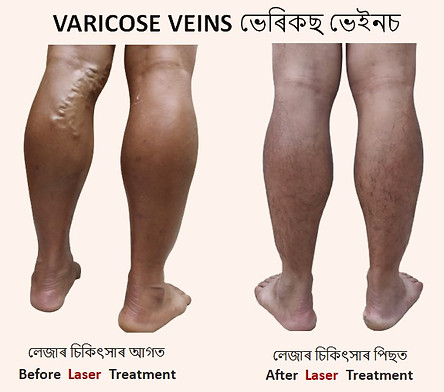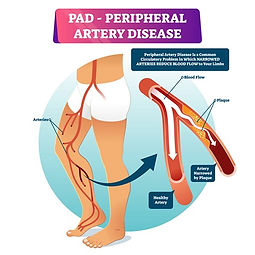Varicose Veins ?
Varicose Veins-Endovenous Laser Ablation :
When does one requires this procedure ?
You require this procedure when dilated veins in your
legs are causing symptoms such as
● Pain in legs by evening.
● Swelling of legs and ankle by evening.
● Skin discolouration around ankle
● Itching around veins.
● Cramping of legs in nights
Who are prone to develop varicose veins ?
● Family history
● Post pregnancy
● Professions requiring prolonged sitting/ standing
● Obese
● Following trauma to limbs
●Long term Smokers
How is it diagnosed ?
Ultrasound scan , to be done in standing position and may require a CT venogram in special instances.
Who does it?
A radiologist trained in imaging guided procedures does it, Interventional radiologist.
What are the alternates ?
● Venaseal- Latest development in treating varicose veins, and is useful in avoiding even the mild complications of laser
● Microwave Ablation: Similar to laser therapy
● RF Ablation: Similar to laser therapy
● Compression bandages -Provide partial symptomatic relief but not permanent cure, has to be worn religiously
● Sclerotherapy- Best suggested for small veins)
● Surgery - Requires admission, general anaesthesia and results in scar
What are the advantages of laser therapy ?
● Success rate of 98%
● Day care procedure, discharged within 24 hours
● Done under local anaesthesia.
● Procedure takes 30 to 60 minutes.
● Can resume work next day
What are the consequences of postponing?
Pressure effects may progress, and may bleed/ulcerate and progress to clots which may extend into deeper veins.
What are the advantages of imaging guidance?
You are assured that vital structures in the path are avoided and the catheter is place in the vessel exactly.
How should I prepare for the procedure?
Shave and do not use any lotion or oil on legs for 24 hours prior to the procedure. You would be kept on overnight fasting, as sometimes a mild anaesthetic may be sometimes given.
How long does the procedure / procedure takes?
The procedure usually takes 30 minutes for a limb, and 60 minutes for both limbs. Depending on the extent of disease , the radiologist decides if you may require additional sclerotherapy to obliterate smaller vessels .
Is it painful?
The procedure is done under local/spinal anaesthesia most of the times. The needle track till the vein would be made numb and pain is not felt.

What is A Varicocele ?
A varicocele is an abnormal enlargement of veins in the scrotum. Normally, veins bring deoxygenated blood back to the heart, but when the blood cannot flow properly, blood builds up and causes veins to dilate. Disruption in blood flow can result from problems with or missing valves in the veins or blockage of the veins. Blockage of the veins can be caused by blood clots, tumors, enlarged lymph nodes, or compression between other blood vessels. Varicoceles are similar to varicose veins, which occur in the legs.

Varicocele - Endovascual Embolization
Who requires this procedure ?
This procedure is indicated in men suffering with reduced sperm count and quality , who had failed to respond to surgical exploration thus hampering the fertility and scrotal pain .
What is the underlying problem?
The underlying disease is abnormal dilatation of veins in the scrotum, which carry the blood back from testis.
What are the consequences of postponing / worst complication if left untreated?
Apart from hampering the fertility , gradual decrease in testicular volume and atrophy can happen over a long term.
How is it diagnosed?
Diagnosis requires a good ultrasound and Doppler study.
What are the steps of procedure?
The dilated veins are blocked by using metallic coils and liquid embolizing drugs.
Why endovascular approach?
Interventional radiology offers percutaneous embolization done through a 3mm hole under local anesthesia as a day care procedure.

what is Uterine Fibroid ?
"GET RID OF FIBROID, NOT UTERUS". BRING YOUR SMILES BACK .... Uterine Fibroid it is one of the most common benign tumour and condition seen in many females.
Uterine Fibroid Embolization :
Who requires this procedure ?
This procedure is indicated in female patients who has fibroids and complain of severe pain during periods, heavy bleeding and requiring multiple transfusions.
What is the underlying problem ?
The underlying disease is abnormal leakage of blood into the uterus , mass effect on urinary bladder and rectum.
What are the consequences of postponing / worst complication if left untreated ?
Slow leakage of blood results in Anemia, heart failure and eventually death.
How is it diagnosed ?
Internal Scan followed by a CT Angiogram
What are the steps of procedure ?
The arterial feeders are identified on Angiogram can be blocked by drugs/coils/vascular plugs using thin wires and catheters.
Why endovascular approach ?
Interventional radiology offers percutaneous embolization done through a 3mm hole under local anesthesia as a day care procedure.


Prostate ?
The prostate is a walnut-sized gland located between the bladder and the penis . The gland surrounds the urethra, the duct that serves for the passage of both urine and semen.
It usually starts to enlarge after 40 years of age. The prostate grows larger due to an increase in the number of cells (hyperplasia) reason being unknown. About half of men aged 51- 60yrs and up to 90% of men over the age of 80yrs will develop an enlarged prostate. “All men will develop BPH if they live long enough,”
When it grows beyond the normal size, it would start causing lower urinary tract symptoms by obstructing the urinary tract. BPH leads to both a decline in urinary-associated and overall quality of life.
Symptoms Include The
The causes of varicose veins vary from person to person. The major reason for the cause of varicose veins could be due to weak or damaged valves. Some of the causes that can contribute to the risk of developing varicose veins are listed below.
-
Increased frequency of urination
-
Frequent urination at night
-
Frequent urination that often produces only a small amount of urine
-
Hesitant or interrupted urine stream
-
Leaking or dribbling urine
-
Sudden and urgent need to urinate
-
Weak urine stream
-
Feeling like the bladder is not completely empty after urinating
-
Occasional pain when urinating
-
Having to rush to the bathroom suddenly after the urge to urinate
-
Sometimes complete obstruction when severe.

DVT ?
How Is Deep Vein Thrombosis Diagnosed ?
-
Duplex ultrasound. This painless procedure ,observe blood flow in veins. Duplex ultrasound is the most common test for DVT.
-
Lab work. Blood work may be done to look for blood clotting and other problems.
What Is The Treatment For Deep Vein Thrombosis?
Specific treatment will be determined by Vascular Interventional Radiologist(IR) :
-
How old you are
-
Your overall health and medical history
-
How sick you are
-
The location of the clot
-
How well you can handle specific medicines, procedures, or therapies.
-
How long the condition is expected to last
-
Your opinion or preference
The goal of treatments is are to prevent the clot from getting larger, to prevent a blood clot from travelling to the lungs (PE), to decrease the chance of another blood clot forming and to prevent development of PTS.
Acute DVT - Mechanical Throbectomy and Thrombosis :
Who requires this procedure ?
This procedure is indicated for patients who develop a clot in the vessels of lower limbs and extending into lower abdomen carrying blood towards the heart.
What is the underlying problem?
The underlying disease is a block in the vessels of the lower limb, thereby reducing the blood return to heart, pooling in lower limbs and painful swelling of lower limbs.
What are the consequences of postponing / worst complication if left untreated?
Unless treated at the right time the patients may eventually land up in sudden death if the clot extends towards heart , failing kidneys and post thrombotic syndrome.
How is it diagnosed?
Diagnosis requires a Doppler scan followed by Angiogram, which is also used to plan the procedure and prognosticate the outcome.
What are the steps of procedure?
The block is cleared using wire and special catheters, lumen is opened using a special vaccum like device and clot resolving drugs and sometimes stents are used to preserve the lumen .
Why endovascular approach?
As most of the patients are unfit for the surgical options and interventional radiology offers solution through a 3mm hole under local anaesthesia as a day care procedure.

What is peripheral arterial disease (PAD) ?
Peripheral arterial disease (PAD) or peripheral vascular disease (PVD) occurs when there is a blockage in the blood vessels that significantly decreases blood flow to the limbs, usually the legs. The blockage can be caused by inflammation or a clot, but it is most commonly caused by atherosclerosis, which is a condition of hardened and narrowed arteries caused by fatty deposits called plaques. Atherosclerosis is typically a condition that affects blood vessels throughout the body, and places the patient at increased risk for heart attack and stroke.
Decreased blood flow decreases the amount of oxygen available to the tissues, which can lead to pain, non-healing ulcers and infections in the limbs and ultimately tissue death called gangrene. If untreated, the affected limb may need to be amputated.

TACE HCC (Trans Arterial Chemo Embolization) ?
Hepatocellular Carcinoma-TACE,RF Ablation and Microwave Ablation
Who requires this procedure ?
This procedure is indicated in patients suffering with hepatocellular carcinoma ( liver cancer) and who are not candidates for surgery.
What is the underlying problem ?
Liver tumors are supplied by arterial branches and their growth can be controlled by occluding the supply .
What are the consequences of postponing / worst complication if left untreated ?
The lesion( cancer ) grows in size and eventually causes death.
How is it diagnosed ?
Triple phase CT/MRI abdomen
What are the steps of procedure ?
The arterial feeders are identified on Angiogram and blocked by chemotherapeutic drugs
Why endovascular approach ?
Interventional radiology offers percutaneous embolization done through a 3mm hole under local anesthesia as a day care procedure.
What is the Procedure in real sense ?
Interventional Radiology Procedure for Liver Cancer
Liver-targeted Cancer Therapy
Liver-targeted therapy offers crucial opportunities for treating liver cancer through the options of Ablation, Chemo-Embolizationand Selective Internal Radiation Therapy (SIRT).


Location
Lachit Lane, House no - 2, First floor, Rajgarh Road, Guwahati - 781007

Email Address
Phone
+ 91 7030643535

...... Life Beyond Vision
Vasocare Superspeciality Clinic
Sarvice Quick Links
Our Contacts
Lachit Lane, House no - 2, First floor, Rajgarh Road, Guwahati - 781007
Call us : +91 - 7030643535
Email : vasocare18@gmail.com
OPENING TIME
Monday to Saturday
09:30 AM - 06:00 PM
Copyright @ 2025 Vasocare Superspeciality Clinic ! Privacy Policy !






